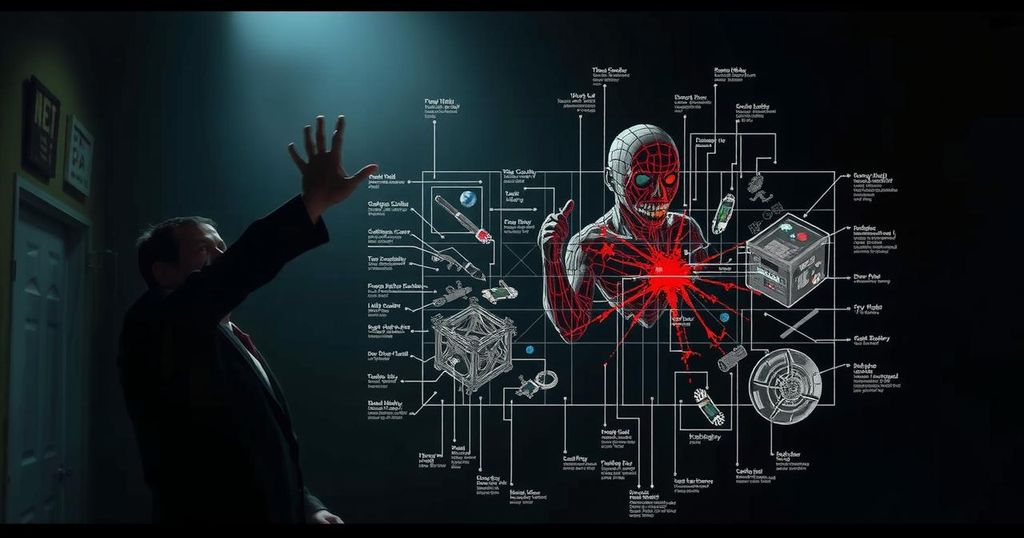Behind the Gruesome Artistry of ‘Terrifier 3’: Effects that Shocked Audiences
The premiere of “Terrifier 3” was a chilling affair, provoking extreme reactions from the audience. Producer Phil Falcone highlighted how these reactions reflect the success of the film’s practical effects. The narrative follows Art the Clown during the Christmas season, showcasing elaborate and gruesome kills. The meticulous makeup process and creative special effects amplify its horror, promising memorable scenes that define the film’s impact.
The U.K. premiere of Damien Leone’s holiday slasher, “Terrifier 3,” unfolded like a chilling horror spectacle, with eleven viewers exiting early and one being physically ill during the opening massacre. For producer Phil Falcone, such visceral reactions are a testament to the artistry and hard work behind the film, particularly highlighting the effectiveness of its practical special effects. “If you’re getting people to vomit and leave the theater… that’s a pretty good job, I’d say,” he proclaimed. In this latest installment, the sinister clown Art wreaks havoc during the holiday season, targeting a character played by Lauren LaVera. With a production budget of $2 million, significantly more than the previous films, “Terrifier 3” serves up some of the most complex and brutal killings in the franchise. The grisly creativity is matched by the intensive makeup process, where actor David Howard Thornton undergoes a lengthy transformation into Art the Clown, involving elaborate makeup techniques and prosthetics that must be meticulously applied. The film’s opening scene is nothing short of gruesome, portraying Art brutally attacking a family dressed for Christmas. Leone’s decision to capture every horrid detail on camera rather than retreating at the moment of impact enhances the shock value, immersing audiences in the horror. Special effects lead Christien Tinsley explained how clever editing made the horrifying impact appear seamless, switching between shot angles to maintain the illusion of a single brutal act. Another eye-catching spectacle involves Art using liquid nitrogen in a bar scene to freeze and then shatter a mall Santa’s limbs. Here, Leone was adamant about achieving a specific look for the effects, wanting the limbs to break delicately rather than shatter like glass. Tinsley shared, “He took it one step further” to ensure that the gore oozes realistically, suggesting an intensity in the design process that reflects the commitment to horrifying authenticity. The crowning achievement of the film, according to Tinsley, is the bathroom scene where Art brandishes a chainsaw at two unsuspecting students. The level of detail involved in crafting various prosthetics and blood effects highlights the complexity of executing such a visual without compromising the horror. “We had blood coming from every direction,” he explained, emphasizing the ambition behind the sequence as one that aims to be memorable in horror cinema.
“Terrifier 3” marks a new high in horrifying storytelling, blending the festive cheer of Christmas with the terror of Art the Clown. Following the success of its predecessors, this installment amplifies both the production value and special effects, underscoring a reliance on practical effects—designing gruesome, unforgettable kills. The dedication of the crew, highlighted through the meticulous makeup process and breakdown of suggestive horror, has positioned this film as a bold exploration of the slasher genre’s boundaries, reflecting a shifting landscape in cinematic scares.
“Terrifier 3” emerges as a standout slasher, characterized by its shocking opening, meticulous craftsmanship, and gruesome creativity. As audiences are thrust into its grisly antics, the film leverages visceral excitement and unforgettable moments that push the envelope of horror entertainment. With a relentless focus on practical effects, it solidifies its place in the pantheon of memorable horror films that audiences will discuss long after the credits roll.
Original Source: variety.com




Post Comment